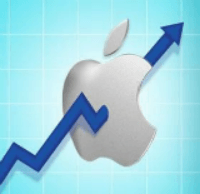The From Line
 iPad passes Mac computer in sales. The tablet is the new frontier.
iPad passes Mac computer in sales. The tablet is the new frontier.
It’s official. Consumers are tablet crazy; so much so that they are choosing the mobile devices over computers. It’s that time again marketers, just when you’ve finally optimized for mobile…
A look into Apples record breaking year provides an impressive example of the tablets’ rapid rise in popularity. In 2011, the company sold over 156 million iOS devices (iPhone, iPad, and iPod Touch), 55 million of which were iPads. To put this in perspective, in just one year combined sales of these mobile devices have exceeded the 122 million Mac computers ever sold. Since it was first available for pre-order in March of 2010, the sales trend of the iPad has blown all other Apple products out of the water (see figure below). CEO Tim Cook commented “This 55 is something no one would have guessed. Including us. To put it in context, it took us 22 years to sell 55 million Macs. It took us about 5 years to sell 22 million iPods, and it took us about 3 years to sell that many iPhones. And so, this thing is, as you said, it’s on a trajectory that’s off the charts.” There has been buzz for some time of the possible upcoming announcement of the iPad3, and today we have verification via Mashable that Apple has sent out invitations for an event on March 7th. The invitation states simply “We have something you really need to see. And touch” and according to Mashable is "superimposed on what is almost certainly an iPad". Knowing this, it is more crucial than ever for marketers to take to heart the magnitude of this trend. It has been rumored that the newest generation iPad will have a full operating system, providing the user with a full blown hand held computer, and conceivably further intensifying this trend. Yes, Apple is just one example, but I think it’s safe to say they are usually ahead of the trend. Assessing how we communicate via tablet will be paramount.
Despite enormous efforts on the part of marketers, email deliverability rates have halted after the first half of 2011, coming in at 81%, according to a study released on September 20th by Return Path.
 Although reasons for this are numerous and often situational, a certain amount of blame in this case can be placed on “priority inbox”. This lovely little tool, created last year by Google, essentially puts a brain within your email account. It sees and records every action and configures message placement accordingly. So what we’re seeing are high reported delivery rates that don’t necessarily reflect the number of messages actually delivered. Technically the provider may have accepted it, but it doesn’t mean it’s landed in the customers’ inbox.
Although reasons for this are numerous and often situational, a certain amount of blame in this case can be placed on “priority inbox”. This lovely little tool, created last year by Google, essentially puts a brain within your email account. It sees and records every action and configures message placement accordingly. So what we’re seeing are high reported delivery rates that don’t necessarily reflect the number of messages actually delivered. Technically the provider may have accepted it, but it doesn’t mean it’s landed in the customers’ inbox.
Images can enhance a message and draw attention to its key components. But, when they are blocked and appear as a big, red X in the recipient’s preview pane (often with the instruction to “right click to download”) they can lose their effectiveness. The reason images are often blocked is to enable users to prohibit unwanted (or inappropriate) images from loading automatically. Blocking images also protects readers from spammers who use them to verify the email address is real.
The impact of blocking images comes in multiple forms (such as lower open rates and disabled banner ads which can hurt advertiser supported material), but they all lead to lower deliverability. Like other delivery issues, email marketers can institute practices to help minimize this issue.
- Get whitelisted and ask your readers to add your company to their “approved sender” or “safe list” to ensure email is allowed through with a minimum of filtering, image blocking included.
- Add a link to view the email online. The “view Web version” links back to a version of the email hosted on your server where images are easy-to-view.
- Provide a prominent text link to the message at the very top of your message so recipients can always choose a text version.
- Before sending check the appearance of your message in the preview pane. Is there enough information to entice the reader to open the message? Or, is the preview pane filled with images and graphics that won’t download.
- HTML is beneficial but don’t neglect the text version of your message. A strong, relevant text version ensures you still reach users, regardless of format preference.
- Don’t ignore text links. If your email includes several key linked images, consider adding text-based links as a caption to the image or in the copy of the message.
As technology and software advances, it is supposed to make our lives easier, right? In most cases, yes, but the latest version of Microsoft Outlook is an exception. It could cause problems for email marketers unaware of the differences between the 2006 and 2007 editions.
The reasons behind the step backwards are not 100 percent clear, but it seems the problem resides in the lackluster rendering ability that will alter the way messages appear in recipients’ inboxes.
The 2007 version doesn’t support new design elements marketers have worked hard to incorporate into their messages including background images, forms, flash or other plugins or animated GIFs. The consensus among experts is that Outlook will strip out images and restrict animation or “motion.”
The bottom line is not to panic and to start developing a plan now to deal with the change and potential problems. Many companies have not made the switch to Microsoft 2003 from 2000, so don’t expect an overwhelming migration to the 2007 version. Instead, use the following recommendations to prepare:
-
Simplify the structure and composition of messages. You can’t go wrong with a simple, elegant design.
-
Update your template. If you haven’t updated your HTML template in the last 18 – 24 months, review it, identify and resolve potential problems.
-
Encourage in-house HTML and graphic designers to get the details of these changes and suggestions from Microsoft by clicking here.
-
Test your messages with multiple accounts including the top consumer email providers (Gmail, Yahoo, AOL and Hotmail).
